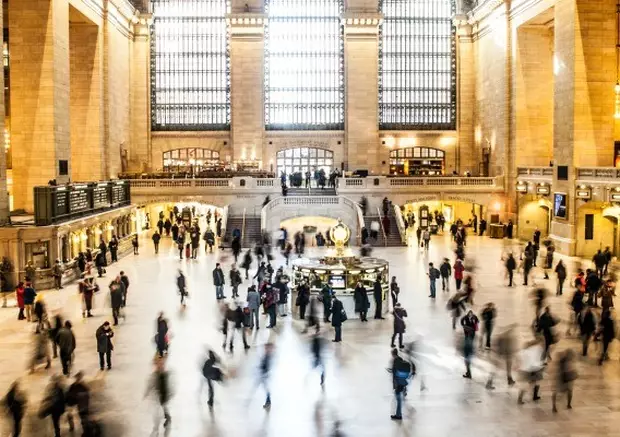
Grand Central Station
- Architectural Grandeur:
- Grand Central Terminal is renowned for its architectural grandeur. The main concourse features a vast, celestial-themed ceiling with a depiction of the zodiac constellations. The iconic celestial mural is adorned with twinkling lights.
- Main Concourse:
- The main concourse is the focal point of Grand Central Terminal. It is a cavernous space with a 125-foot high ceiling. The floor is made of Tennessee marble, and the information booth in the center is a popular meeting point. The concourse is surrounded by shops and restaurants.
- Terminal Clock:
- One of the most recognizable features of Grand Central is the large four-faced clock atop the information booth in the center of the main concourse. This has been a traditional meeting point for New Yorkers.
- Beaux-Arts Architecture:
- Grand Central Terminal is a masterpiece of Beaux-Arts architecture. The exterior is adorned with classical details, including columns, statues, and a majestic facade. The interior spaces are equally impressive with decorative elements and exquisite detailing.
- Whispering Gallery:
- Located near the Oyster Bar & Restaurant, the Whispering Gallery is a unique architectural feature. The acoustics of the arched entryway allow for a whispered conversation to be heard clearly on the other side.
- Transportation Hub:
- Grand Central Terminal serves as a major transportation hub, connecting subway lines and commuter trains. It is a key terminal for the Metro-North Railroad, serving destinations in the northern suburbs of New York City.
- Retail and Dining:
- Grand Central Terminal offers a diverse range of shops, boutiques, and dining options. From upscale restaurants to casual eateries, visitors can find a variety of culinary experiences.
- Events and Exhibitions:
- The terminal hosts occasional events and exhibitions, including art installations, cultural performances, and seasonal displays.
- History and Preservation:
- Grand Central Terminal has a rich history and played a crucial role in the development of New York City’s transportation infrastructure. It was nearly demolished in the mid-20th century but was saved through preservation efforts, leading to its designation as a historic landmark.
- Vanderbilt Hall:
- Vanderbilt Hall, located just off the main concourse, is a spacious area that is often used for special events, exhibitions, and holiday markets.
Numbers or statistics related to Grand Central Terminal in New York City. While I may not have the most up-to-date specific numerical figures, I can provide some general information:
Size and Space:
Grand Central Terminal covers 48 acres in total.
The main concourse is vast, spanning 22,000 square feet.
Passenger Traffic:
Grand Central Terminal is one of the busiest train stations in the world.
It serves over 750,000 commuters and visitors daily.
Tracks and Platforms:
The terminal has 44 platforms and 67 tracks.
These tracks serve Metro-North Railroad trains heading to and from destinations in New York and Connecticut.
Renovation Cost:
Grand Central Terminal underwent a massive renovation in the late 20th century, which was completed in 1998.
The renovation cost was estimated to be around $200 million.
Celestial Ceiling Details:
The celestial-themed ceiling in the main concourse is adorned with approximately 2,500 stars.
The constellations depicted are based on how they appeared on the night of October 27, 1913.
For the most accurate and up-to-date numerical information, especially regarding passenger traffic, financial details, or recent renovations, check with official sources, such as the Metropolitan Transportation Authority (MTA) or Grand Central Terminal’s official website. They often provide the latest statistics and information about the terminal.
Grand Central Terminal is not just a transportation hub; it’s a cultural and architectural landmark that attracts both commuters and tourists, offering a glimpse into New York City’s rich history and vibrant present.
![]()


Potrebbe anche piacerti:

The Chrysler Building
29 Febbraio 2024
The Empire State Building
1 Ottobre 2021